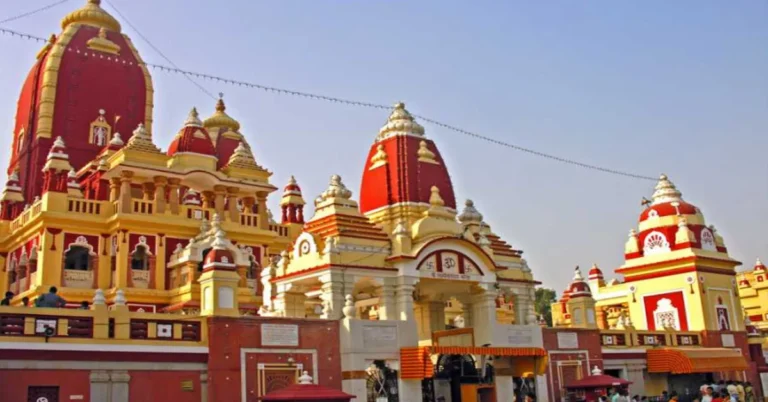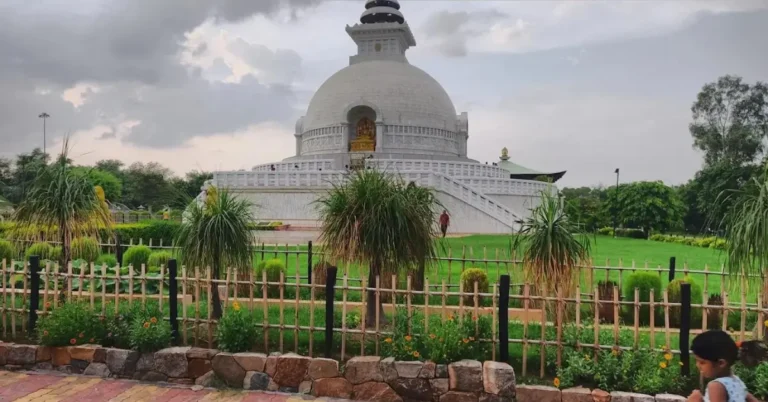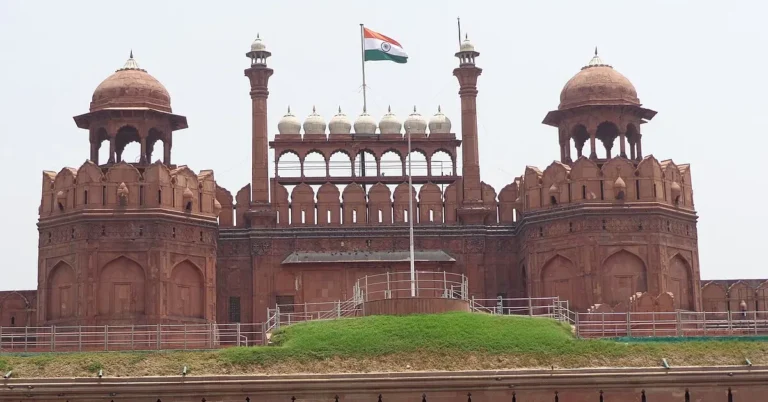Red Fort: A Complete Guide to Delhi’s Most Famous Monument

The Red Fort, also known as Lal Qila, is one of Delhi’s most famous places, known for its beautiful Mughal architecture and rich history. It was built in 1648 by Emperor Shah Jahan and served as the main home for Mughal emperors for almost 200 years. The fort’s high red walls, detailed marble palaces, and lovely gardens show the grandeur of the Mughal period.
The Red Fort is also important in India’s history. On August 15, 1947, India’s first Prime Minister, Jawaharlal Nehru, raised the national flag here, celebrating the country’s independence from British rule. Today, it stands as a symbol of India’s freedom and cultural pride.
This guide will take you through the Red Fort’s history, its key features, and useful tips for visiting. Whether you’re interested in history or simply want to explore, this guide will help you enjoy your visit to Delhi’s most famous monument.
History and Architecture
The Red Fort was built between 1638 and 1648 by Emperor Shah Jahan. Made mostly of red sandstone, the fort is a great example of Mughal architecture. Its huge red walls stretch for over 2 kilometers and surround a complex with palaces, gardens, and mosques. The main entrance, called the Lahori Gate, is particularly impressive.
During the Mughal era, the Red Fort was the center of power and ceremonies. The emperor held important meetings and celebrations here. Later, when the British took control of India, they used the fort as a military base.
Within the fort complex, you’ll find several notable structures. The Diwan-i-Am (Hall of Public Audience) was where the emperor spoke with common people. The Diwan-i-Khas (Hall of Private Audience) was used for meetings with special guests. The Moti Masjid (Pearl Mosque) is a beautiful small mosque made of white marble.
Key Highlights of the Red Fort
The Red Fort has several key attractions that are worth seeing during your visit. Here are some of the main highlights:
Diwan-i-Am: The Hall of Public Audiences
The Diwan-i-Am is a large hall where the Mughal emperor would meet with the public. This hall is famous for its grand design, which could hold thousands of people. The emperor would sit on a high throne, known as the Jharokha, and listen to the concerns of his subjects. The hall is beautifully decorated with detailed carvings and marble screens.
Diwan-i-Khas: The Hall of Private Audiences
The Diwan-i-Khas was used for meetings with important guests and diplomats. This hall is known for its rich decoration, including marble inlays and beautiful chandeliers. The emperor would sit on a special throne called the Takht-i-Taus, and hold private discussions with selected guests. The hall’s luxurious design reflects the Mughal dynasty’s wealth and art.
Moti Masjid: The Pearl Mosque
The Moti Masjid, or Pearl Mosque, is a small mosque made of white marble. Its simple and elegant design is often compared to pearls. The mosque’s peaceful and beautiful appearance makes it a quiet place for reflection and adds to the fort’s charm.
Mumtaz Mahal: The Pearl Palace
Mumtaz Mahal, or the Pearl Palace, is another beautiful building in the fort. Known for its marble decoration and fine design, this palace was used as a private area for the emperor’s family. Its elegant arches and intricate designs make it a key feature of the fort.
Flag Hoisting Ceremony on Independence Day
On August 15, Independence Day, the Red Fort hosts a special flag hoisting ceremony. It was here that Jawaharlal Nehru, India’s first Prime Minister, raised the national flag in 1947, marking India’s independence from British rule. This ceremony is an important symbol of India’s freedom.
Light and Sound Show
The Light and Sound Show is a popular event that takes place at the fort in the evening. It uses lights, sounds, and storytelling to bring the history of the Red Fort to life. It’s a fun and informative way to learn about the fort and its past.
Red Fort, Delhi Timings and Entry Fees
Red Fort Timings
The Red Fort is open every day except Monday. You can visit from 9:30 AM to 4:30 PM, giving you plenty of time to explore the fort’s many attractions. It’s a good idea to arrive early to avoid large crowds and see everything at a relaxed pace. Be aware that the fort may close earlier on special days or during certain events, so it’s smart to check for any updates before you go.
Entry Fees
The entry fees for the Red Fort are:
- Indians: INR 35 per person
- Foreign Tourists: INR 550 per person
- Children Under 15 Years: Free
If you want to visit the Moti Masjid (Pearl Mosque) inside the fort, there is an additional fee of INR 10 for both Indian and foreign visitors. You can buy tickets at the entrance, and it’s best to carry cash as card payments might not always be accepted.
Additional Information
If you plan to take photos, you may need to pay an extra fee for using a camera. The fort has basic facilities like restrooms and a small snack shop, but bringing your own water and snacks is a good idea, especially if you plan to spend a lot of time exploring. Knowing the timings and fees will help you plan your visit to the Red Fort more smoothly.
Popular Places to Visit Near Lal Qila Delhi
The Red Fort is close to several interesting places you can visit.
Chandni Chowk is a busy market right next to the Red Fort. It’s a lively area with many shops, street food stalls, and traditional items. It’s a great place to experience the energy of old Delhi and try some local snacks.
Not far from Chandni Chowk is Jama Masjid, the largest mosque in India. Built by Emperor Shah Jahan, this huge mosque can hold up to 25,000 people. Its impressive design and tall minarets make it a key landmark to visit.
Another nearby spot is Raj Ghat, where Mahatma Gandhi, the leader of India’s independence movement, was cremated. It’s a simple and peaceful place with a black marble platform to honor his memory.
If you have more time, visit Akshardham Temple. It’s a modern Hindu temple complex with stunning architecture, beautiful gardens, and a multimedia water show. Although it’s a bit farther from the Red Fort, it’s worth seeing for its impressive design and attractions.
Visiting the Red Fort
How to Reach Lal Quila or Red Fort
There are several ways to reach the Red Fort:
By Metro: The nearest metro station to the Red Fort is Jama Masjid. It is well-connected to other parts of Delhi.
By Bus: There are several buses that stop near the Red Fort. You can check the Delhi Transport Corporation (DTC) website for the bus routes.
By Taxi: You can hire a taxi or auto-rickshaw to reach the Red Fort.
Best Time to Visit
The best time to visit the Red Fort is during the cooler months from October to March. The weather is pleasant during these months, making it more comfortable to explore the fort’s vast grounds. It’s also advisable to visit early in the morning to avoid large crowds and to make the most of the daylight hours. Weekdays are generally less crowded than weekends, so plan your visit accordingly if you want a more peaceful experience.
Essential Tips for Visiting the Red Fort
- Arrive Early: To avoid crowds and enjoy a peaceful visit, arrive early in the morning when the fort opens.
- Wear Comfortable Shoes: The fort is large, and you’ll be walking a lot. Comfortable shoes will make your visit more enjoyable.
- Carry Water: Bring a bottle of water to stay hydrated while exploring the fort, as it can get quite hot.
- Dress Modestly: Dress modestly to respect the cultural and historical significance of the site. Avoid wearing revealing clothes.
- Check for Events: Verify if there are any special events or closures on the day of your visit to plan accordingly.
- Use a Guide: Consider hiring a guide or joining a tour to learn more about the history and significance of the fort.
- Camera Fees: If you plan to take photos, be aware that there might be an additional fee for camera use.
- Respect the Rules: Follow all signs and instructions, especially in restricted areas, to ensure a respectful visit.
- Explore the Museums: Take time to visit the museums within the fort for a deeper understanding of Mughal history and art.
- Plan Your Visit: Allocate at least 2-3 hours to explore the fort thoroughly, including its main attractions and notable structures.
These tips will help you have a smooth and enjoyable visit to the Red Fort, making the most of your time at this historic monument.
Conclusion
The Red Fort is a remarkable example of India’s history and beautiful architecture. Built by the Mughal emperors, it shows the greatness of their rule with its grand halls, elegant mosque, and lovely palace. Key parts like the Diwan-i-Am, Diwan-i-Khas, and Moti Masjid highlight the skill and artistry of the time. The fort is also important for its role in India’s history, especially during the flag hoisting ceremony on Independence Day.
Visiting the Red Fort is a great way to learn about India’s past and enjoy its stunning design. It’s a place where you can see history up close and experience the beauty of Mughal architecture. If you’re interested in history or just want to explore a beautiful and important site, the Red Fort is a must-visit. Plan a trip to see it for yourself and discover all it has to offer.
Frequently Asked Questions
What is Red Fort famous for?
The Red Fort is a UNESCO World Heritage Site that was built by Mughal Emperor Shah Jahan. It is famous for its stunning red sandstone walls, beautiful palaces, and gardens. The fort also served as the main residence of the Mughal emperors for over 200 years.
Why is Red Fort red in colour?
The Red Fort gets its name from the red sandstone used in its construction. This sandstone, which is a type of sedimentary rock, naturally has a reddish hue due to the iron oxide it contains.
What is the history of Lal Qila?
The Red Fort, or Lal Qila, was built in 1648 by Mughal Emperor Shah Jahan as the main residence of the Mughal dynasty. It was designed to be a symbol of power and grandeur, and its construction was a major feat of engineering and architecture. The fort’s red sandstone walls and intricate carvings are a testament to the skill and artistry of the Mughal artisans.
What is the ticket price of Lal Kila?
The ticket price for Lal Kila (Red Fort) depends on your nationality. the entry fee is:
- Indian citizens, SAARC citizens, and BIMSTEC nationals: INR 10
- Foreigners: INR 250
- Photography is generally allowed
- Videography is subject to a fee of INR 25.
- Light and Sound Show Tickets
- Adults: INR 80
- Children: INR 30
Which day is Red Fort closed?
The Red Fort is closed on Mondays. It is open to the public from Tuesday to Sunday, 9:30 AM to 4:30 PM. The best time to visit the Red Fort is during the cooler months of October to February, when Delhi is less crowded and the weather is pleasant.




